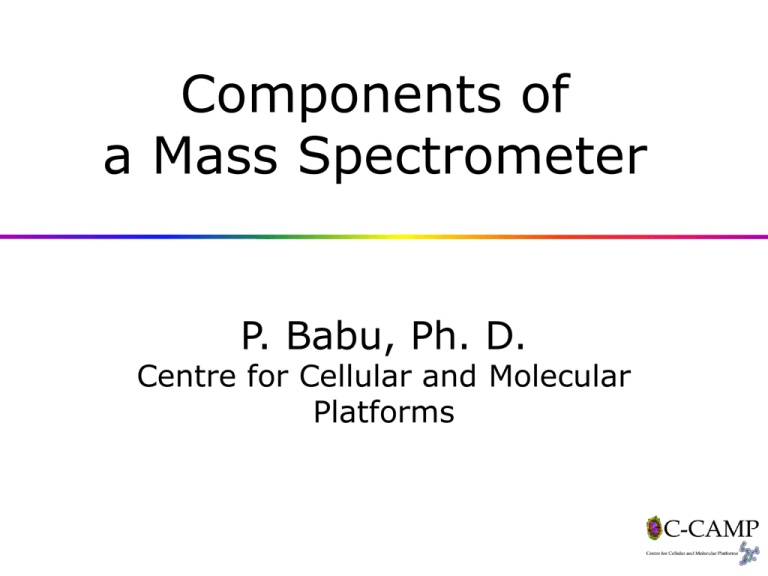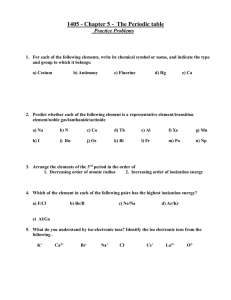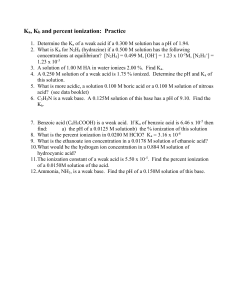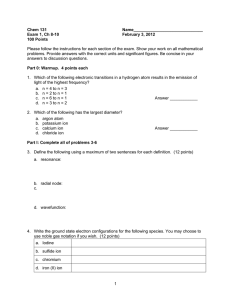Components of a Mass Spectrometer - C-CAMP
advertisement

Components of a Mass Spectrometer P. Babu, Ph. D. Centre for Cellular and Molecular Platforms Mass spectrometer Mass spectrometer is an instrument that measures the mass-tocharge ratio (m/z) values and their relative abundances of ions ................. Relative abundance Mass spectrum m/z – mass to charge ratio Base peak Isotopic peak Molecular ion m/z Mass Mass unit 1 u = 1 Da = 1.660 540 × 10−27 kg. Molecular mass : Exact mass of an ion or molecule calculated using the mass of the most abundant isotope of each element Molar mass: Mass of one mole (6x1023 atoms or molecules) of a molecule/compound (i.e. isotope-averaged atomic mass for the constituent elements) MS principle D+ + R. eM M 2e- +. D + N +. M+ -Molecular ion; D+ - Daughter ion or product ion Only charged species are detected in MS e.g. [M+nH]n+; [M-nH]n-; [M+Na]+ JJ Thamson’s 3rd Parabola Mass Spectrograph Components of a Mass Spectrometer ........... Sample Inlet HPLC GC Syringe Plate Capillary Ion Source Electron Ionization (EI) Chemical (CI) APCI APPI Electrospray (ESI) Fast Atom Bombardment (FAB) MALDI Analyzer Sector Quadrupole TOF Orbitrap FTICR Detector Data collector and processor Photoplate Faraday cup Electron multipliers (MCP) Solid-State Image current Sample Inlet HPLC GC Syringe Plate Capillary Ion source The role of the ion source is to create gas phase ions 1) Analyte atoms and molecules are transferred into gas phase 2) Ionization Hard (high energy) ionization and Soft (low energy) ionization Electron Ionization (EI) Chemical (CI) Spray Ionization (APCI, APPI, ESI) Desorption Ionization (FAB, MALDI, SALDI) Gas discharge ion sources (e.g. Inductively Couple Plasma) Ambient Ionization (DESI, LAESI) Electron impact ionization (EI) High energy (70 eV) ionization – fragmentation of molecules Chemical Ionization (CI) is similar to EI except that a reagent gas is ionized first which in turn transfers charge to analyte molecules or an atom Electrospray ionization Taylor cone The exact mechanism of ion formation is still not clear Multiple charged ions are produced Sensitivity depends upon the flow rate of analyte solution Very soft ionization – less fragmentation, non-covalent complex Fast atom bombardment (FAB) Liquid sample (matrix is mixed with sample) is bombarded with energetic atoms (Xe or Ar atoms of 10KeV); ions are generated through sputtering Predominantly singly charged ions are formed Chemical background due to matrix cluster ions and fragments are disadvantages Soft ionization – fragmentation gives partial sequence information Matrix Assisted Laser Desorption Ionization (MALDI) Sample is mixed with a matrix (light-absorbing, low-mass molecules) and excited with UV laser pulse (ns) Different matrix molecules are used for different classes of analytes Ionization is done at very low pressure (<10-6 torr) Very soft ionization – good ion source for biomolecules Analyzers A mass analyzer is a device that can separate atoms and molecules according to their mass Sector Quadrupole TOF Orbitrap FTICR The five main characteristics for measuring the performance of a mass analyzer are 1) the mass range limit or dynamic range 2) the analysis speed [u (m)S-1] 3) the transmission = No. of ion reaching the ions/No. of ions entering mass analyzer 4) the mass accuracy 5) the resolution Resolution and Mass accuracy Resolution = FWHM = m/m Mass accuracy = theoretical m/z vs measured m/z (ppm) Sector analyzer m/z = B2r2/2V Sector analyzer Benefits Double focusing magnetic sector mass analyzers are the "classical" model against which other mass analyzers are compared. . Classical mass spectra . Very high reproducibility . Best quantitative performance of all mass spectrometer analyzers . High resolution . High sensitivity . High dynamic range . Linked scan MS/MS does not require another analyzer . High-energy CID MS/MS spectra are very reproducible Limitations . Not well-suited for pulsed ionization methods (e.g. MALDI) . Usually larger and higher cost than other mass analyzers . Linked scan MS/MS gives either limited precursor selectivity with unit product-ion resolution, or unit precursor selection with poor product-ion resolution Quadrupole analyzer Quadrupole analyzer Benefits . Classical mass spectra . Good reproducibility . Relatively small and low-cost systems . Low-energy collision-induced dissociation (CID) MS/MS spectra in triple quadrupole and hybrid mass spectrometers have efficient conversion of precursor to product Limitations . Limited resolution . Peak heights variable as a function of mass (mass discrimination). Peak height vs. mass response must be 'tuned'. . Not well suited for pulsed ionization methods . Low-energy collision-induced dissociation (CID) MS/MS spectra in triple quadrupole and hybrid mass spectrometers depend strongly on energy, collision gas, pressure, and other factors. Time-of-flight (TOF) analyzer Time-of-flight (TOF) analyzer Benefits . Fastest MS analyzer . Well suited for pulsed ionization methods (method of choice for majority of MALDI mass spectrometer systems) . High ion transmission . MS/MS information from post-source decay . Highest practical mass range of all MS analyzers Limitations . Requires pulsed ionization method or ion beam switching (duty cycle is a factor) . Fast digitizers used in TOF can have limited dynamic range . Limited precursor-ion selectivity for most MS/MS experiments Orbitrap analyzer Harmonic oscillations Ions of specific mass-to-charge ratio move in rings which oscillate along the central spindle. The frequency of these harmonic oscillations is independent of the ion velocity and is inversely proportional to the square root of the mass-to-charge ratio (m/z or m/q). Hu et. al. J. Mass Spectrom. 2005; 40: 430–443 Comparison of various analyzers Detectors The role of the detectors is to convert the energy of the incoming ions into a current signal that is registered by the electronic devices and transferred to the acquisition system of MS Photoplate Faraday cup Electron multipliers (MCP) Solid-State Image current (Orbitrap and FT ICR) Faraday Cup Electron multipliers (MCP) MCP MS MALDI or ES IONISATION x+ m/z COLLISIONAL ACTIVATION + + + + MS/MS m/z Tandem MS (MSn) ................... Ion Source Analyzer Analyzer Detector Collision Cell Data collector and processor Hybrid Tandem MS Instruments Reflector improves the resolution Linear Detector Reflector Tribrid Fusion Orbitrap (Thermofisher) Source 2 region Deceleration stack Timed ion selector Collision cell Reflector detector Laser and Camera Sample plate Source 1 region Q-Tof Applied Biosystems, USA MALDI-TOF/TOF References 1) Mass spectrometry – Principles and applications by Edmond de Hoffmann 2) Mass spectrometry – Instrumentation, interpretation and applications by R. Ekman, J. Silberring, A. W- Brinkmalm and A. Karj




